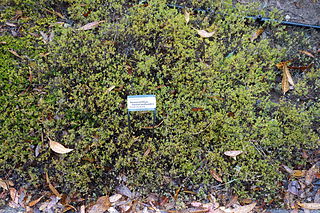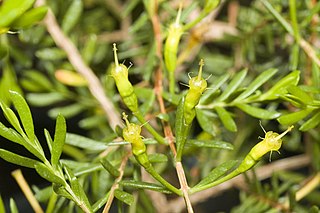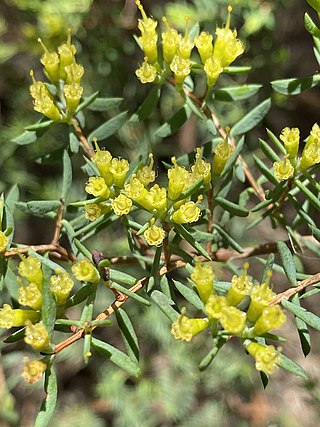
Homoranthus is a genus of about thirty species of plants in the myrtle family Myrtaceae and all are endemic to Australia. Plants in this genus share similarities with those in both Darwinia and Verticordia. They are shrubs with their leaves arranged in opposite pairs and with flowers appearing either singly or in small groups, usually in upper leaf axils. They are found in Queensland, New South Wales and South Australia. The genus was first described in 1836. None of the species is common nor are they well-known in horticulture.

Homoranthus flavescens is a plant in the myrtle family Myrtaceae and is endemic to northern New South Wales. It is a low, spreading, flat-topped shrub with cylinder-shaped or flattened leaves. Single yellow to reddish flowers appear in leaf axils in late spring and summer, forming clusters near the end of the branchlets.

Homoranthus darwinioides, commonly known as fairy bells, is a species of flowering plant in the family, Myrtaceae. It is a small, spreading shrub with pendulous yellow and pink flowers, grey-green leaves and is endemic to New South Wales.

Homoranthus homoranthoides is a plant in the myrtle family Myrtaceae and is endemic to South Australia.

Homoranthus biflorus is a flowering plant in the family Myrtaceae and is endemic to a small area in northern New South Wales. It is an erect shrub with cylinder-shaped leaves and small groups of usually yellow flowers.

Homoranthus virgatus commonly known as twiggy homoranthus, is a species of flowering plant in the family Myrtaceae and is found growing in coastal areas of northern New South Wales and in Queensland. It is an upright shrub with wand-like branches, aromatic foliage and white to pink flowers in small clusters at the end of branches.

Homoranthus floydii is a plant in the myrtle family Myrtaceae and is endemic to New South Wales.

Homoranthus bebo is a flowering plant in the family Myrtaceae and is endemic to a small area in northern New South Wales. It is a low-lying shrub with leaves that are usually flat and with groups of up to ten yellow flowers. It is only known from the Dthinna Dthinnawan Nature Reserve near Yetman.

Homoranthus binghiensis is a flowering plant in the family Myrtaceae and is endemic to a small area in northern New South Wales. It is an upright shrub with pointed leaves and usually paired yellowish to red flowers.
Homoranthus brevistylis is a plant in the family Myrtaceae and is endemic to a small area in Queensland. It is an upright shrub with pointed, linear leaves and groups of up to four pale yellow flowers in leaf axils. It is only known from the Blackdown Tableland National Park.
Homoranthus bruhlii is a plant in the family Myrtaceae and is endemic to a small area on the Northern Tablelands of New South Wales. It is an upright shrub with glabrous, pale green, linear leaves and with groups of three or four pale yellowish green flowers in leaf axils. It is only known from a single population near Tenterfield.

Homoranthus cernuus is a flowering plant in the family Myrtaceae and is endemic to a small area in the Wollemi National Park. It is a slender shrub with smooth, linear shaped leaves and pairs of pendulous cream-coloured flowers with a pinkish base.
Homoranthus cummingii is a plant in the myrtle family Myrtaceae and is endemic to a small area in Queensland. It is an upright shrub with pointed, linear leaves arranged in alternating opposite pairs so they form four rows along the branchlets. The flowers hang downwards in pairs and are creamy white to pale yellow, turning red as they age. It is only known from Mount Zero north-west of Townsville.

Homoranthus decumbens is a plant in the myrtle family Myrtaceae and is endemic to a small area in Queensland. It is a low, spreading shrub with cylindrical leaves arranged in alternating opposite pairs. The flowers are yellowish green and arranged singly in upper leaf axils.
Homoranthus elusus is a plant in the myrtle family Myrtaceae and is endemic to a small area on the Northern Tablelands of New South Wales. It is an shrub with linear leaves and with groups of up to four flowers in leaf axils. It is only known from a single specimen collected near Tenterfield.
Homoranthus inopinatus is a plant in the myrtle family Myrtaceae and is endemic to a small area in southern Queensland. It is an upright shrub with linear leaves and with groups of three to six flowers in leaf axils near the end of branchlets. It is only known from a single small population on private property near Ballandean.

Homoranthus lunatus, commonly known as crescent-leaved homoranthus, is a flowering plant in the family Myrtaceae and is endemic to a small area in northern New South Wales. It is a spreading shrub with curved leaves and small groups of up to six yellow flowers in leaf axils.

Homoranthus porteri is a plant in the myrtle family Myrtaceae, and is endemic to a small area in northern Queensland, Australia. It is an upright shrub with creamy-white to red pendulous flowers in pairs on a short stalk with red bracts and small linear leaves.

Homoranthus prolixus, commonly known as granite homoranthus is a flowering plant in the family Myrtaceae and is endemic to northern New South Wales. It is a spreading shrub with linear to lance-shaped leaves and groups of up to six yellow to red flowers in the upper leaf axils.

Homoranthus vagans is a flowering plant in the family Myrtaceae and is endemic to a small area in southern Queensland. It is a shrub with pointed linear leaves and groups of up to ten yellow flowers in leaf axils near the end of branchlets. It is only known from a single population north of Inglewood.















